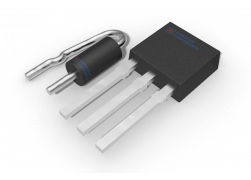Filter
Please note:

Minimum order amount: 500 UAH
Quantity of SMD: multiples 100 pcs
Structural characteristics of fast recovery output diodes
The internal structure of a fast recovery diode is different from that of a conventional diode. It adds an I base region between P-type and N-type silicon materials to form a P-I-N silicon wafer. Since the base area is very thin, the reverse recovery charge is very small, which not only greatly lowers the trr value, but also reduces the transient forward voltage drop, so that the tube can withstand high reverse operating voltage.
The reverse recovery time of fast recovery diodes is typically several hundred nanoseconds, the forward voltage drop is about 0.6 V, the forward current is from a few amperes to several thousand amperes, and the reverse peak voltage can be from several hundred to several thousand volts.
The reverse recovery charge of the ultrafast recovery diode is further reduced so that its trr can be as small as tens of nanoseconds.
Most fast and ultra fast recovery diodes up to 20A are in TO-220 package. In terms of internal structure, they can be divided into two types: single and paired (also called double). Inside the pair tube are two fast recovery diodes.
According to different methods of connecting two diodes, there is a common cathode-tube and a common anode-tube. Fast recovery diodes for tens of amperes are usually packed in TO-3P metal cases. Pipes of higher power (from several hundred amperes to several thousand amperes) are in the form of a hermetically sealed bolted or flat type casing. Comparison of performance and parameters
The following table compares the characteristics of Schottky diodes and ultrafast recovery diodes, fast recovery diodes, silicon high frequency rectifier diodes, and silicon high speed switching diodes. It can be seen from the table that although the trr of silicon fast switching diodes is extremely low, the average rectified current is very small and cannot be used for high current rectification.
Reverse recovery time
What is Reverse Recovery Time? When the voltage of an external diode momentarily changes from forward to reverse, the current flowing through the device cannot, accordingly, instantly change from forward to reverse. At this time, minority carriers (holes) injected in the forward direction are extracted by a strong electric field in the space charge region. Since the density of these holes is higher than the equilibrium hole density in the base region, the reverse bias torque The reverse current, which is much higher than the reverse leakage current, is the reverse recovery current of the IRM. At the same time, the enhancement of the coincidence process also accelerates the decrease in this additional carrier density, until the additional carriers accumulated in the base region completely disappear, the reverse current drops and stabilizes to the reverse leakage current. The time elapsed during the entire process is the reverse recovery time. Determination of the reverse recovery time trr: the time interval during which the current passes through the zero point from the forward direction to the specified low value. It is an important technical metric for measuring the performance of high frequency flyback devices and rectifiers.
Distinguish between Schottky diodes and fast recovery diodes
- 1. The principle of the structure: a Schottky diode is a combination of precious metals and n-type semiconductors, while a fast recovery diode is a regular pn with a thin base.
- 2. A fast recovery diode is a diode with a short reverse recovery time (less than 5 μs). Gold alloying measures are often used in this process. The structure uses a PN junction structure, and some have an improved PIN structure. The forward voltage drop is higher than that of conventional diodes (1-2V), and the reverse withstand voltage is mostly below 1200V.
In terms of performance, it can be divided into two levels: Fast Recovery and Super Fast Recovery. The reverse recovery time of the first is hundreds of nanoseconds or more, and the second is less than 100 nanoseconds.
A Schottky diode is a metal-semiconductor barrier diode called a Schottky barrier diode that has a reduced forward voltage (0.4-0.5 V) and a short reverse recovery time (10-40 nanoseconds), and a current reverse leakage is large, withstand voltage is low, usually less than 150V, and is mainly used at low voltage. 3. The voltage of the reverse breakdown of Schottky diodes in most cases does not exceed 60 V, and the maximum value is only about 100 V., which limits its use. The reverse peak value of fast recovery diodes can be as high as hundreds or thousands of volts, so this is similar to reusing pulse power transformers.
Use only fast recovery (UFRD) for high frequency rectifier diodes above 100 V. 4. The Schottky forward voltage drop is only 0.4 V and the fast return to the second hall is 0.6 V. Schottky diode is very small, its frequency response will only be due to the limitation of the RC time constant, it is an ideal device for high frequency and fast switching. Its operating frequency can reach 100 GHz. In addition, MIS (metal-dielectric-semiconductor) Schottky diodes can be used to make solar cells or LEDs.
Fast recovery diode: 0.8-1.1V forward voltage drop, 35-85 ns reverse recovery time, and fast switching between on and off, which increases the frequency of use of the device and improves the waveform. The fast recovery diode manufacturing process uses gold-alloyed and pure diffusion processes to provide faster switching speed and higher withstand voltage. Currently, fast recovery diodes are mainly used as rectifier components in inverter power supplies.
